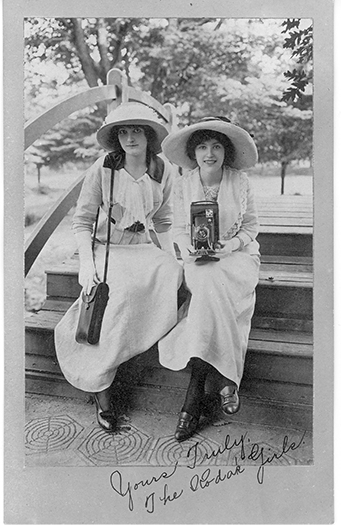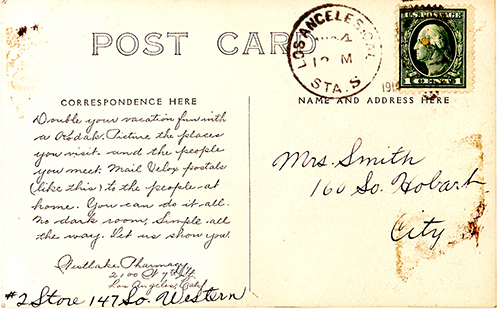
Kodak Girls Postcard

Kodak Girls Postcard
I was motivated to buy this vintage postcard for a number of reasons, but primarily because it was used to promote the sale of postcard cameras and processing. The Kodak Girl in the photograph is holding a No. 3A Folding Pocket Kodak, Kodak's first "postcard" camera.
My favorite photographic format is the 3 1/4 x 5 1/2 inch postcard. This format was introduced to amateur photographers in 1903 with the very popular No. 3A Folding Pocket Kodak. A variety of postcard cameras were produced by Eastman Kodak over a forty year period. Kodak's last postcard camera, the No. 3A Kodak Series III was discontinued in 1943. Kodak used the code 3A as their designation for most, but not all, of their postcard format cameras. Any Kodak camera with 3A in its name made postcard-sized images.
Ansco Company, another major American camera manufacturer and a fierce competitor of Kodak's, manufactured approximately ten different camera models in the postcard format. Ansco also used the code 3A to signify postcard format camera models, but not exclusively.
Postcard format cameras were very popular in the first three decades of the 20th century, as was the pastime of taking and mailing personal photographic postcards.
According to the KodakGirl Web site, Kodak made available to retailers, pre-printed postcards for use in direct-mail advertising campaigns. A variety of Kodak Girl advertising postcards can be found on Martha Cooper's KodakGirl Web site. Here is a direct link to the site's Advertising Postcard page.

Back of Postcard
This postcard was mailed by the Westlake Pharmacy, 2100 W. 7th St., Los Angeles, California, to a Mrs. Smith of Los Angeles. The date stamp is difficult to read. The year is in the 1910s. According to the KodakGirl website, Kodak pre-printed the postcard image, the correspondence text and retailer's name and address. Notice the address of a second store was written with the same ink and handwriting as the addressee information, and this is obviously different from the pre-printed message script.
The image on my postcard matches one featured on the KodakGirl website. However, with the exception of the final sentence, the message is different. The purpose of both postcards was to promote Kodak postcard cameras and processing services.
I've transcribed the message on my postcard. It reads:
"Double your vacation fun with a Kodak. Picture the places you visit, and the people you meet. Mail Velox postals (like this) to the people at home. You can do it all. No darkroom. Simple all the way. Let us show you."
The similar postcard on the KodakGirl website was mailed from Virginia. That message seems a bit more folksy to me than the upbeat California inducement to "Double your vacation fun...". Must be that California sun.
The postcard advertising message mentioned Velox postals. Velox was a brand of Kodak photographic printing paper available in a variety of grades and sizes. It was also available as postcard stock, that is, it was sensitized on one side and pre-printed on the opposite with the characteristic features of a postcard. Postcard cameras make images on standard photographic film just like any regular camera. The only thing special about a postcard camera is the dimension of the negative it produces. The typical postcard camera image was approximately 3 1/4 x 5 1/2 inches, at a time when the standard USA postcard measured 3 1/2 x 5 1/2 inches.
Because postcard camera negatives were the same size as a postcard, they could be printed directly onto postcard printing paper without concern for cropping the image. This kept everything direct and simple for the photographer and processing lab - a form of what-you-see-is-what-you-get.
For the majority of amateur photographers, film processing and printing was handled by Eastman Kodak, Ansco Company or other commercial processing laboratories. Amateur and professional photographers with access to a darkroom could purchase postcard paper from Ansco or Kodak and make their own postcards.

|
Page created May 12, 2005;
updated December 20, 2020 |